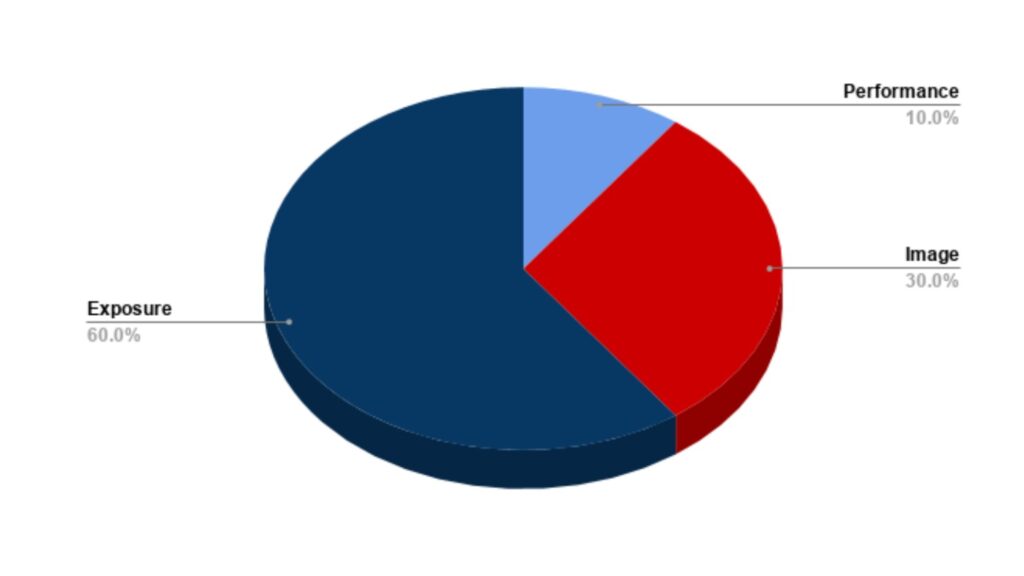Do you feel you deserve a promotion or better pay at work? Your success at work depends on more than your performance. Harvey Coleman in his book, Empowering Yourself: The Organizational Game Revealed, explains why one\’s progress at work depends essentially on three things: performance, image, and exposure, or PIE. Understanding this concept and applying it could make a huge difference in your career, especially during the COVID-19 pandemic and into the future.
Here is a simple graphic to help put things in perspective:

The PIE for Success at Work
First, the performance factor comes across as a given to most people. But the surprising insight Coleman puts forward is that your performance only amounts to 10% of what you need to succeed at work. Only 10%!
Your image, that is, how you are perceived at work or what people think about you, ranks higher at 30%.
The last piece of the PIE, exposure, refers to the visibility of your achievements to people that matter at work. This takes up a whopping 60% of the total. Effectively, your exposure is the biggest piece of the PIE and the most crucial factor. Let’s take a closer look at each piece.
1. Performance
What do you do at work? Do you do your job well? This is essentially what this factor points at, and it is where most of us have our focus, at least, those people who pride themselves on their diligence at work.
We work hard. But working hard does not guarantee progress or promotion at work. In fact, meeting and exceeding your set goals, key performance indicators or objectives is no guarantee either. According to Coleman, your performance only takes 10% of the equation.
While your performance may get you into an organization and keep you employed, making progress within it requires your attending to the other elements of Image and Exposure. Work hard, it is the foundation for the other pieces of the PIE. But do remember to pay attention to these other factors because they carry considerable weight.
2. Image
The second piece of the PIE is your image or personal brand. It encompasses the totality of your outlook, how you are perceived within the organization. Your actual performance is one thing, but do colleagues, senior colleagues, perceive you as reticent, negative, or uncooperative?
Are you great at your job, but don’t pay enough attention to how you appear at work? Your image is an important piece of the equation, and by Coleman’s calculation, this is a whopping 30% of the deal. What is your score here? What are you going to do about it?
Dr. Tayo Oyedeji, the CEO of Overwood, once told a story about a situation where the board of a company he led sought to promote a suitable candidate to a senior management position. Two names showed up on the list, but interestingly the majority of the board decided to shun the individual with the better qualifications and achievements on the job.
Their reason? He didn’t look the part. The candidate dressed oddly, coming to work in, for instance, flowery or bright-colored shirts. He didn’t fit the image of the person they wanted to have in that role and that became an obstacle to his success at work. Fortunately, the story does not end there. We will see where it leads as we consider the final piece of the PIE.
3. Exposure
This is the most important piece of the PIE. How well are your contributions and achievements visible or traceable to you? Even where you work on a team, you will have to make that extra effort to ensure that your unique contributions are seen and acknowledged by colleagues at all levels.
While this may be seen as self-promotion or arrogance in certain environments, your work here is to study the nature of your particular organization and find ways to have your achievements documented, visible, and traceable.
One way you can achieve this is to be open to new or lateral responsibilities. Is there a call for volunteers for a new project? How about signing up? Is there a difficult customer call or visit your organization or team needs to make? Consider joining the team or making the call.
And when you do take these steps, ensure you give a report in writing, beyond any verbal communication. You can even get creative with the process: arrange to have lunch or coffee with the relevant person where you can share progress about your work, but remember to connect it with an interest or goal he or she will find beneficial to their own progress at work.
The rest of the story
Back to the earlier story, the candidate was saved when the managing director intervened on his behalf. He convinced the board to offer him a three-month probationary promotion while he worked with him to sort out his image. Why did the director do this? He was aware of the candidate\’s capabilities and history of performance.
So you see, while the individual scored poorly as regards his image, he scored very high marks with his performance and exposure and hence could have the leader speak up on his behalf. What if his contributions at work, for some reason, could not be traced to him?
Through the Glass Ceiling
Are we talking about becoming better at office politics? No. The pieces of the PIE are in harmony: if you do your work well, you stand a chance of projecting an image of a dependable, professional person while paying attention to other factors (such as your dressing and interpersonal skills), and ultimately if you keep at building your brand, you consistently attain new levels of exposure as you take on more responsibility in contributing to the organization’s success.
Where there are no guarantees in business or in life for that matter, you stand a far better chance of succeeding progressively in your career when you pay attention to your performance, image, and exposure at work. This, perhaps, is your elevator through the glass ceiling–if it cannot be broken–at your workplace.
What do you think? Which part of the PIE do you think you should pay attention to at work?
If you enjoyed reading this post, please like and share it with your friends. We will also be happy to read your comments.


